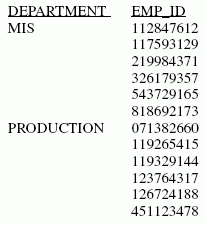- When using the display command LIST with a BY phrase, the LIST counter is reset to 1 each time the major sort value changes.
- The default sort sequence is low-to-high, with the following variations for different operating systems. In z/OS the sequence is a-z, A-Z, 0-9 for alphanumeric fields; 0-9 for numeric fields. In UNIX and Windows the sequence is 0-9, A-Z, a-z for alphanumeric fields; 0-9 for numeric. You can specify other sorting sequences, as described in Specifying the Sort Order.
- You cannot use text fields as sort fields. Text fields are those described in the Master File with a FORMAT value of TX.
- You can use a temporary field created by a DEFINE command, or by the DEFINE attribute in a Master File, as a sort field. In order to use a temporary field created by a COMPUTE command as a sort field, you must use the BY TOTAL phrase instead of the BY phrase.
- If you specify several sort fields when reporting from a multi-path data source, all the sort fields must be in the same path.
- Sort phrases cannot contain format information for fields.
- Each sort field value
appears only once in the report. For example, if there are six employees
in the MIS department, a request that declares
PRINT LAST_NAME BY DEPARTMENT
prints MIS once, followed by six employee names. You can populate every vertical sort column cell with a value, even if the value is repeating, using the SET BYDISPLAY parameter. For details, see Controlling Display of Sort Field Values.
The following illustrates how to display all employee IDs by department.
TABLE FILE EMPLOYEE PRINT EMP_ID BY DEPARTMENT END
The output displays a row for each EMP_ID in each department:
